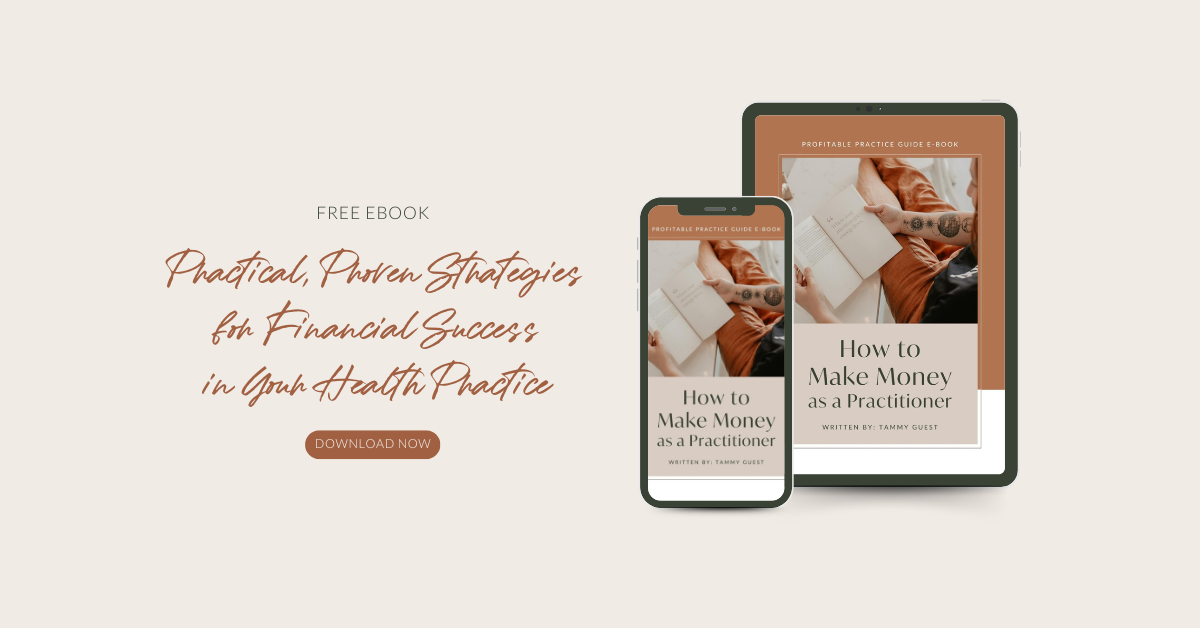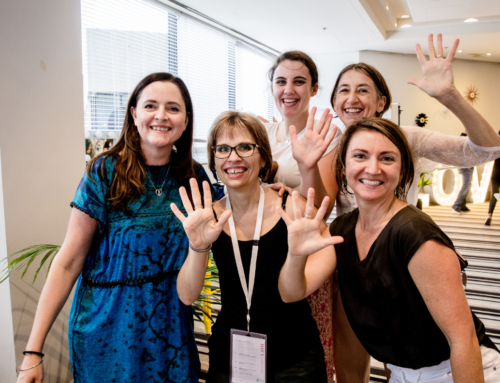Lots and lots of questions have been coming up in the Hub and the Club about ‘doing all the things’ but nobody’s buying. And also questions about how to get potential clients on board with the things you know will help them, but don’t know how to get them to change their mind about what is going to be best for them.
So today I’m going to talk about 10 mental triggers that we need to address before somebody changes their mind.
This can be really helpful in clinical practice when you’re trying to get somebody to change their mind about the things that they’re doing for themselves and it can also be really beneficial if you’ve got a program, workshop, or event that you are sharing with people but they’re not clicking the button to buy. Or even just to get someone to buy into an idea that you know will be beneficial for them.
Trigger #1: Story
The first mental trigger is a story. We are all humans and the thing about being a human is it’s in our DNA to get information through a story. It used to be cavemen sitting around a fire and sharing generational knowledge and passing it down from one person to another, and sharing that wisdom in a way that will be remembered, by telling a story that gets us to feel a certain way.
How can you make a story impactful enough for somebody to see themselves in the story?
(Tip: If you’re really interested in story, go and check out Joseph Campbell’s work on the hero’s journey. It’s a big subject.)
One way is a high-low-high.
At the beginning of a story, we start with something like, “I was doing really well in pathology. I loved my work, I loved the people that I worked with, I loved the variety that I worked in the hospital system and I got paid super regularly. But then I had to go and see an 85 year old patient at about 3 a.m. I had to take her blood and she was so dehydrated and tired, it was really obvious from her gum science and nail signs that she was missing out on vitamins and nutrients. But at the time, I didn’t know what to tell her at 3 a.m. in the morning when I couldn’t take her blood. I knew something had to change for me and it was at that point in time I decided to leave pathology, re-establish myself, and get the knowledge I needed to get to actually help this person on a whole other level. That’s what turned me around to becoming a naturopath. I retrained as a naturopath and I loved being able to then help 7,000 people with all sorts of different conditions.
See how the high-low-high gets you to think about how you fit into my story?
What’s your high-low-high and how could you share your story in relation to either the thing you’re trying to sell or the referral partner you’d like to work with? How can you tell a story that’s a high-low-high that’ll flip a mental trigger in their head and let them see how they fit into a story similar to yours?
Trigger #2: An Event
This has two prongs. An event can be you sharing an inside image about a moment that changes everything. An event can also be an actual event, such as getting people in a free webinar or an open day for your new clinic. You’re creating a collective memory that allows them to be involved and to remember that as an event. It’s a platform for them to create a mental trigger, like an anchor back to what you do and how you do it.
When it comes to your sales page, an event might be a countdown. Perhaps you need to create a launch rather than just having your eCourse that sitting on your website. Having a launch event, a moment in time that people buy in and they get maybe a bonus or something, a moment in time that they buy into it is going to move them more than having it available all the time.
When there are 500 of you and everybody does it at the same time, there’s a mental trigger that happens about FOMO – about missing out – that allows them to take action and be involved in. The event is in the actual motivation.
Trigger #3: Social Proof
One of the reasons people don’t get involved in things is because they might not know you or trust you.
In our profession, social proof is when we’ve heard through word of mouth that something works. We are so much more likely and motivated to change and choose that as an option.
This is the interesting thing about third party places for naturopaths. I can’t speak to all of the different practitioner sets that I speak to, but for naturopaths having a third party place like White Coat and similar sites where people leave testimonials can really help you.
Since you haven’t selected the people who are writing testimonials for you there, you are not ethically out of alignment or out of integrity with the H Triple C and the Triple C guidelines. Other people are able to put in whatever they would like on that third party site and it has nothing to do with you because they can put any point of view on there as a testimonial. But having that on your website gives you social proof that you are the person you say you are, that you have helped people before and that you are somebody who can create motivation to change in someone’s health or well-being.
If you have an e-course or something similar and somebody has gone through that e-course, then you want to make sure you have some type of testimonials for the eCourse. You need that social proof that other people have gone through your course and found it beneficial on your sales page. Just having a sales page that has your course details are not going to hit on these mental triggers.
Note that e-course testimonials are very different from one-on-one consultation testimonials. Testimonials for knowledge-based information products are fine. The ones for one-on-one consultations as you and you as a practitioner are in a grey area at the moment.
Trigger #4: Scarcity
Scarcity is a really cool one and you may have seen it all over the internet. Sometimes it’s strategically put there and other times it’s not on purpose at all, it just happens to be like that.
Scarcity works with FOMO. Scarcity is either you’ve only got a limited time, a limited number of spaces, or you’ve got a limited number of the product. I mean think about it – there have been times when I bought things online because there’s only a few left. I think, “People have been watching this at the same time as me, I don’t want to miss out!”
Scarcity can come with a countdown clock. If you are doing a launch, it may mean they won’t get those bonuses unless they sign up on that last day. It could be a time or resource scarcity. Perhaps you only have ten of these days, books, cards or whatever. You only have ten of them so you need to take action now so that you can create that change that you want.
FOMO is a human condition that we don’t want to miss out. We want to experience as many experiences as we can, especially the ones that we have an identity relationship with.
Trigger #5: Authority
How can you show that you are somebody who can contribute to the conversation? How can you show that you have either done the work, you’ve remembered the things you needed to remember from your qualification, and you have an authority in that area? What is on your sales page or in your pitch or even when you are one-on-one in clinic – how can you share your authority?
What about your degree? Your diploma? Your certificate? All of those things are visual representations of authority.
So on your sales page, is there something that shows that you’re a professional? Is there something that shows that you have contributed to this conversation before? Maybe you’ve appeared in a magazine article and you can attach that. Maybe you’ve been able to speak somewhere or have this conversation before – add that image on your sales page. Maybe it is videos.
Authority also comes with the know, like, and trust factor. If you have a large following on social media you want to share that on your sales page so that you’re ticking the box for somebody to go, “Oh yes, I want to work with you because it’s obvious that you’re an authority in this area.”
I often find with practitioners who are just releasing their first e-course and they haven’t been on social media at all, they haven’t been in the conversation about the thing that they’re releasing. Say for instance you want to do an e-course on kidney health just because you know nobody else is doing a course on kidney health. And you’ve just spent the past couple of weeks trying to ignore that you’ve got a blog and you’ve been ignoring your Facebook page, your Instagram page has a bunch of pictures of your dogs on it, and you only talk in private groups on Facebook about your love of kidneys. Then you put out your kidney e-course and you wonder why nobody’s bought it.
If you have contributed to the conversation of kidneys on your Facebook page and you’ve been writing for three months about kidneys and you wrote a blog about kidneys or you’ve been quoted in an article somewhere as a naturopath or a nutritionist or a health practitioner, you can then use that authority on your sales page.
Trigger #6: Anticipation
This is where bonuses are involved. Apple is a prime example of anticipation. They have used the mental trigger, the motivational change of anticipation to sell many, many iPhones. There is anticipation every time a new one comes out, even though it does the exact same thing as what the last version. We see on the news people lining up outside the Apple shop when something new appears. There’s a level of anticipation that comes with it and then we, like the people standing there, are anticipating it. Everybody’s anticipating it on the news websites, and everywhere else. Then it’s quickly followed by FOMO.
The same thing happens when you are setting yourself up to share your programs with people. How can you do that in an innovative way to seed the idea? How can you pre-frame it to the customer so that they are looking for it everywhere? How can you seed the idea so that when it comes out everyone’s actually really interested in it?
A good example is Elizabeth Gilbert when she was writing Big Magic. She would share on social media “about writing my book today,” or “here’s a picture of me writing in this area,” “here’s a thing,” “I’m nearly finished!” Seeing all of this makes people want to go out and get the book because you have seeded the idea. You’ve got them anticipating the moment where they will be able to buy the book.
Trigger #7: Common Enemy
A common enemy is when there is something worth being moved by internally enough that you will do something to change. This might be an idea or a notion or a big body of people, places, government, whatever it happens to be. An idea that everybody is actually so moved against that they are moved to change can be used for good.
And it can be used in your sales, as well. For us in particular, one of our common enemies would be this ridiculous situation that we have in health at the moment, where every day the numbers go up for diabetes. Every day the numbers go up for cancer. Every day the numbers go up in suicide and mental health conditions. And every day the numbers go up for chronic conditions and nobody is doing anything about it.
That is a common enemy – these numbers going up – and the motivation to change because of this yucky feeling makes it 7 times more likely for somebody to press the button than it is for the aspirational yummy stuff.
We might have seen it with the gun laws over in America with all of the teenagers and the kids that got on board because there was a common enemy and there were literally hundreds of thousands of people marching the streets that were kids because they were so moved to create change from having a common enemy. Of course, they had stories involved, and they had anticipation for an event involved. Can you see how there’s a shift in a movement to change if you’re hitting on all of these mental triggers?
Trigger #8: Proof
How can you prove that the thing you are selling to somebody is actually going to help them?
Wherever you can create proof, whether it’s social proof that we talked about before in the context of testimonials, people who have experienced your particular program, or whatever it happens to be, or whether it’s scientific articles, statistical or data-driven details.
Maybe you can truthfully state that 80% of participants said that they would tell their friends about it? Or 10% of clients then go on to make a million dollars? These statistical data-driven facts allow people to be motivated to change.
Deanna Minich does amazing little ones where she gets the snippets of the most recent research and gives a statistical piece on how this particular way of thinking, this particular lifestyle medicine, or this particular nutritional medicine can help.
So how can you create proof?
Trigger #9: Commitment or Consistency to the Conversation
I talk about this all the time. How can you be more consistent and more persistent in being in the conversation? How can you be there when that person is asking that particular question about the thing that you are really passionate about?
Again, it’s not just the sales page and it’s not just in that moment. It is how can you consistently contribute to the conversation so that when your thing comes out it’s a no-brainer. Customers are going to think, “Yep, that’s the person that does the kidney thing, and that’s the kidney thing, and these are the people I know with kidneys stuff, so I will send it towards the kidney people.”
How can you be persistent and consistent? This can come across in the offline world where are you speaking, what conferences you are going to, what further studies you are doing, and how are you sharing all of these things online. Maybe Instagram or Facebook. Are you creating blog posts for Medium? If you don’t have a website yet, Medium is a great place to start having conversations about the thing you’re interested in. If you do have a website, are you creating consistent conversations there? And LinkedIn – how are you creating consistent conversations about the thing you’re interested in over there?
Where could you be more consistent and persistent? Because it’s over a long time that shows commitment to a particular conversation. It shows that you’re not randomly going from this to that, but you have a body of work that can be trusted and that you are the person to go to for that information.
Trigger #10: The Law of Reciprocity
Number 10 is one of my favourite mental triggers because it works on the universal law of reciprocity.
The rule of reciprocity is all about the more you give, the more you get back. So when you are setting yourself up to get your new program out into the world, how can you give more so that energy does this? How can you give and then the flow starts to happen?
Reciprocity is how you can create a position where you are actually giving pretty much all of your stuff away for free. All chunks people can’t look up at once because it’s overwhelming. But inside your course, you’ve got all of it very well-placed and progressive, taking them on a journey. How can you give away bits of information that’s gonna get them to say yes?
You see it all the time when somebody helps you. All you want to do is help them back. The other day I was in a public transport during the school holidays and somebody helped me getting my son off the public transport. Then all I wanted to do was help them. I wanted to be of service to them because they had been of service to me.
One of my online clients happens to live very near me and she was in all sorts of a bind this past week. There was no conscious thought all, I just immediately wanted to help. So I put together some pieces that I had around the house – some tea and other things that I knew would help her instantaneously feel better. And I went round and gave them to her. Last night, I came home and there’s this beautiful bunch of flowers there. That’s reciprocity in its most extraordinary and I was so moved I was crying. Because I didn’t do any of that expecting anything back, but her note said how amazing it was to have had somebody that she doesn’t really know come and see her and all she wanted to do was show her appreciation.
This is just one example of reciprocity because you don’t intend on doing it. But you can see how it works in someone’s mind and especially in your own mind when you are on the receiving end. Somebody’s giving, so all you want to do is just energetically give back.
It’s exactly the same when it comes to your offering. How can you use the rule of reciprocity in your business where you are giving in a way that is just of yourself? How can you give bonuses that aren’t gonna take a whole bunch of time, effort, or energy? You’re just doing it from your heart and your intentions are to create bonuses that are gonna rock somebody’s world that isn’t gonna take too much away from you.
Can you create a PDF or a checklist or something just that you have around? Like I was, I thought, “God, I’ve got this and I’ve got the tea and I’ve got the other bits and pieces and I was like of course I can give it.”
How can you create that in your course? How can you create it in what you offer to your clients that you can just help them in an extra way that then creates that rule of reciprocity? That makes them think, “I’m getting all of these things. Of course, I’m going to click the button. Oh, of course, I’m going to. I’m certain this person can help me.
How can you create that?
Recap
So the ten mental triggers that we just talked about or the motivations for change that you can create for your sales page, for getting somebody on board with their treatment program, or when you are having a conversation for referrals are:
- Story – remember the high-low-high
- Event – create an inciting event that makes somebody shift and change
- Social Proof – share in a way that’s ethical and with integrity how somebody else has benefited from your work
- Scarcity – create a situation where people are noticing their FOMO enough to make a change
- Authority – share with visuals or other means how you are contributing to the conversation and have qualifications on this subject matter
- Anticipation – pre-frame or seed an idea or event to create excitement for your upcoming thing
- Common Enemy – always use this in a good intentional way, such as the example of health numbers going up
- Proof – use research and data to motivate people to change
- Commitment & Consistency – be consistent and persistent with your message so you are established before your course comes out
- Reciprocity – be generous of heart in a way that doesn’t drain you to create an energetic flow of reciprocity
11. Surprise – the surprise #11 is Surprise! (You all know I love a surprise)
How can you create surprise as part of your mental triggers for people to move and to create change? Some of these come with long-term programs. For instance, if you are creating a long-term program, how cool is it to send out little surprises along the way that make people feel loved and cared for. Maybe a handwritten note and you’re making sure that they understand that they are heard they’re seen, they’re visible, and they’re cared for.
This is a good one! I have a platform for my membership site called AmbitinAlly. Last year, Nathalie Lussier who runs the AmbitionAlly sent this book out to thousands of customers. It’s all about taking an idea from “Go to Whoa!” So how cool is that?
How cool is it to have surprise as an element when it comes to creating a mental trigger to make sure that people are continually motivated to change.
There are the 11 (10 plus one) mental triggers you can use if you are having a hard time getting people in your program, on a retreat, or into a sales page.
Take Action
It’s much easier to see this in action than it is to take action ourselves, so what I’d love for you to do is start to notice when you are on a sales page and you are about to click to buy somebody’s stuff – use your business eyes now that you know the mental triggers. I want you to start to scan and see where they have used which mental triggers. Which ones you notice and which ones you’re internally motivated by. Which ones get you going.
Identify the mental triggers that you’re resonating with and it’s very likely if you’re resonating with it, the people around you that you are attracting as customers or clients or potential clients will be triggered by it too. So use that on your content and on your pages. Reverse engineer what works on you and use it yourself.
If you got a gold nugget out of this, please share it! Also please share what you actually take action on.
If you know anybody else who needs to hear this, please share this article with them so that this can get out to all of our communities and we can start to actually share and create motivational change in all the people that we are here to help.
Tammy x









Leave A Comment